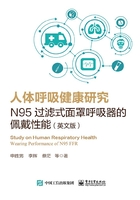
2.4 Conclusion
This chapter investigated the filtration performance of various multi-fiber filters.3D models of the fibrous media were constructed using the software Gambit.The gas-solid flow inside the fibrous media and the particle tracking were then simulated using the ANSYS Fluent and DPM solving model.The effects of the fibrous structures and parameters of fibers on the pressure drop and filtration efficiency were also studied.The obtained conclusions are:
(1) Compared to the parallel design,the staggered design exerts higher filtration efficiency but its pressure drop is higher.Therefore,the staggered design was selected as the research object for the following study.
(2) Because of different trapping mechanisms,the filter's filtration efficiency for large particles (dp=0.5μm,0.8μm and 1.0μm) increases significantly with the face velocity increases.However,its filtration efficiency for small particles (dp=0.1μm and 0.2μm) is insensitive to the face velocity.Moreover,back-row fibers make only a small contribution to the filtration efficiency.
(3) The filtration performances of the even,dense-sparse and sparse-dense structures with a same total SVF were compared.The pressure drop of the even structure is the lowest while the other two almost have the same pressure drop.In addition,the dense-sparse structure has the highest filtration efficiency for all the simulated particle sizes but it is associated with a higher pressure drop.
(4) Using a large number of thin fibers improves the filtration efficiency for all particle sizes but results in a higher pressure drop.In addition,partially removing sections of fibers can improve the filtration performance.